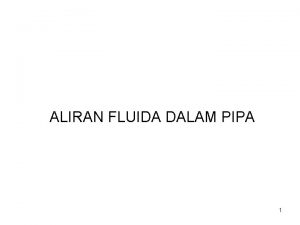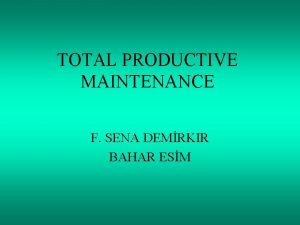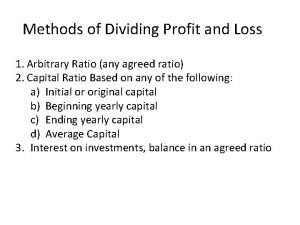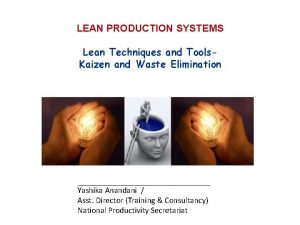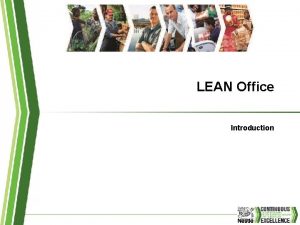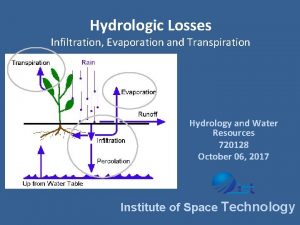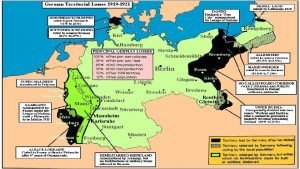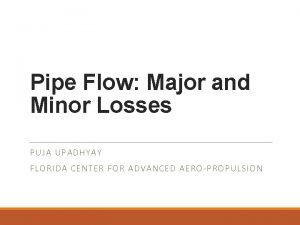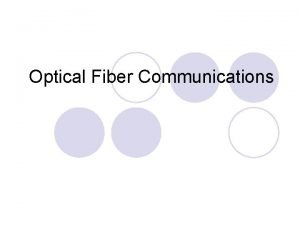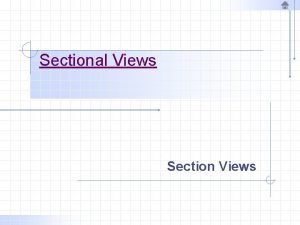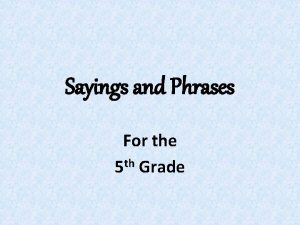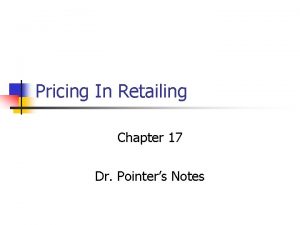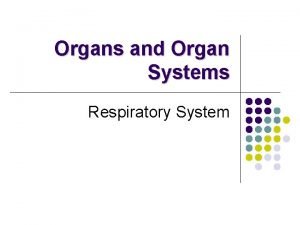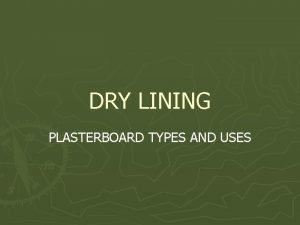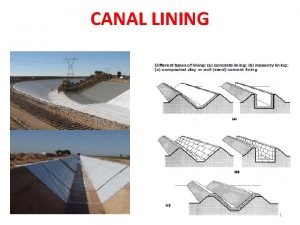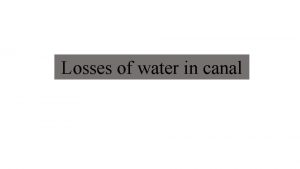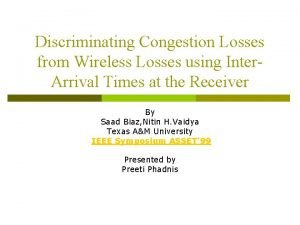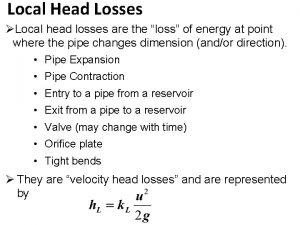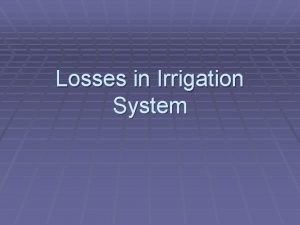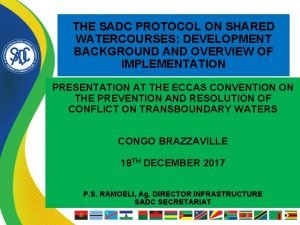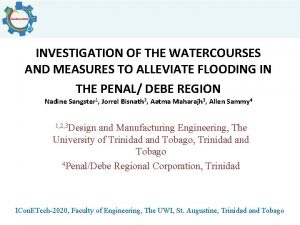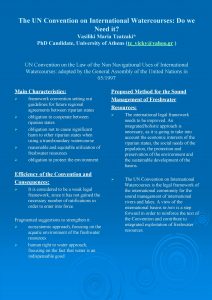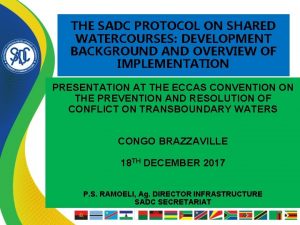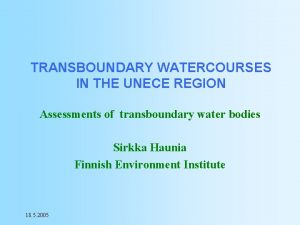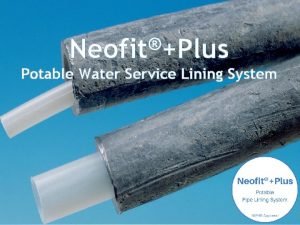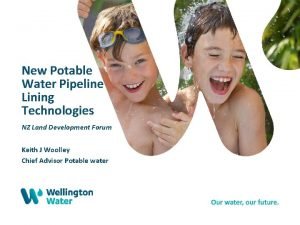LINING IMPACT ON WATER LOSSES IN WATERCOURSES Dr























- Slides: 23

LINING IMPACT ON WATER LOSSES IN WATERCOURSES Dr. M. Arshad Dr. Q. Zaman Dr. A. Madani

BACKGROUND • • Rural population (68 %) depends on agriculture Employs over 70% of labour force 80% of foreign exchange earnings Contributes 24% to GNP

CHALLENGES Increase food production with: • Less water (Countries with limited water and land resources) • Effective and sustainable use of water (agriculture) • Require urgent and immediate solution (in view of intensifying competition)

LAND RESOURCES OF PAKISTAN Geographical area Cultivable area (suitable for agriculture) Cultivated area (Irrigated + Barani) Irrigated area by all sources Additional area (Need to be Irrigated) = 79. 3 Mha = 31. 2 Mha = 22. 1 Mha = 18 Mha = 9. 2 Mha Population of Pakistan = 170 Million

WATER RESOURCES OF PAKISTAN Rainfall • Annual rainfall (125 mm in South-East to 750 mm North-West) • Total water generated by rainfall is 32 BCM • Contribution to crops is 10 -20% Groundwater • Exploitation of Groundwater is 59 BCM • 7, 000 private tubewells • 40% of total supply at farm-gate Surface Water Resources • • • Total Inflow is 171 BCM Tarbela (10. 38 BCM - 485 ft), Mangla (5. 90 BCM - 380 ft) 48 Canals (61000 km), 19 Barrages 1, 70, 000 Watercourses (1. 6 Million km)

Source: World Bank, 2005

PROBLEMS OF IRRIGATION SYSTEM • • Inefficiency in conveyance and application of water Inadequacy of available water supplies Inequity of distribution of water Unreliability of water supplies Increased cropping intensity Inadequacy of drainage facilities Inadequate and diminishing storage capacities

AVAILABILITY OF WATER AND LOSSES System component Available at Head (BCM) Loss (%) % of total Inflow River system 171 42 24 24 Canals 129 34 27 20 Watercourses 95 43 45 25 Field application 52 15 28 9 Crop use 37 Total 22 100 Overall Irrigation System Efficiency 22. 3%

WATERCOURSE LOSSES

FUTURE VISION OF PAKISTAN Year 1951 1961 1971 1981 1991 2000 2013 2025 Population Water availability (Million) per capita (m 3) 34 5300 46 3950 65 2700 84 2100 115 1600 148 1200 207 850 267 659 Water Scarcity <1000 m 3

STRATEGIES TO MITIGATE WATER SHORTAGE Ø Long Term • Construction of new reservoirs • Policy for the Groundwater exploitation etc. Ø Medium Term • Lining of watercourses to save good quality water Ø Short Term • Adopt pressurized irrigation techniques and RCT

Objectives • To assess and measure the water losses in unlined and lined watercourses on the same command • To analyze the impact of lining on the water losses from the watercourses

Experimental Site - Ghourdour Distributary (1. 36 m 3 s-1) of Upper Gogera Branch of - - Lower Chenab canal irrigation system Ghourdour Distributary § 20. 7 km long § 43 watercourses § Command area of 8251 ha Rice-wheat agro-ecological zone Major crops (summer)- Rice, sugarcane, and forage Major crops (winter)- Wheat, sugarcane and forage

Selected Watercourses Watercourse No. Designed discharge (L s-1) 37 Total length (m) 2439 Average water depth (m) 0. 305 Bottom width (m) 0. 406 28000/R (unlined) 17 1909 0. 152 0. 611 25373/R (lined) 41 5727 0. 279 0. 508 28915/L (lined) 7 1273 0. 191 0. 711 26680/R (unlined)

Measurement of Water Losses • • • Inflow-outflow method Cutthroat flume used (at upstream and downstream) 0. 20 m X 0. 91 m Section of 244 m to 305 m length (to measure the water losses) Three replications of water flow measurements were made

Watercourse No. 26680/R 28000/R 25373/R 28915/L Test Inflow rate (L s-1) Outflow rate (L s-1) Section length (m) 1 2 3 28. 34 34. 01 24. 09 29. 76 305 305 Average 32. 02 27. 77 305 1 2 3 17. 00 19. 84 14. 17 17. 00 244 244 Average 18. 99 16. 15 244 1 2 3 36. 84 34. 01 35. 43 32. 59 31. 17 32. 59 305 305 Average 35. 43 32. 02 305 1 2 3 8. 50 7. 65 274 274 Average 8. 50 7. 65 274

W/C No. Test Loss (L s-1 Per 100 m) 26680/R (unlined) 28000/R (unlined) 25373/R (lined) 28915/L (lined) Percentage loss (flow per 100 m length) Loss (m 3 s-1 per million. m 2) Total loss (L s-1) 1 2 3 1. 39 4. 91 4. 10 10. 95 19. 27 23. 13 Average 1. 39 4. 37 10. 95 21. 77 1 2 3 0. 93 5. 47 4. 69 8. 93 10. 88 12. 70 Average 0. 93 4. 94 8. 93 12. 15 1 2 3 1. 39 0. 93 3. 78 2. 73 2. 62 13. 04 8. 72 19. 16 17. 69 18. 42 Average 1. 11 3. 05 10. 41 18. 42 1 2 3 0. 28 3. 28 2. 56 2. 98 Average 0. 28 3. 28 2. 56 2. 98

Results and Discussions • W/C No. 26680/R (unlined) q 21. 77 liter per second q Losses - 68% of the flow • W/C No. 28000/R (unlined) q 12. 15 liter per second q Losses - 64% of the flow • W/C No. 25373/R (lined) q 18. 42 liter per second q Losses - 52% of the flow • W/C No. 28915/L (lined) q 2. 98 liter per second q Losses - 35% of the flow

Comparison of Water Losses Between Unlined and Lined Watercourses Watercourse No. Average loss (%) Unlined Lined 26680/R 68 - 28000/R 64 - 25373/R - 52 28915/L - 35 Average 66 43. 5 Average loss difference (%) 22. 5

• Unlined watercourses - water losses ranged from 64 to 68% • Lined watercourses - water losses ranged from 35 to 52% • Comparing the average water loss - 66% (unlined) to the 43. 5% (lined) watercourses Lining reduced water loss by 22. 5% • • Watercourses - Same type of soil hydraulic characteristics Maintenance conditions - Very poor Discharge of watercourse was greater than its capacity. Water losses - higher due to spilling

Condition of Lined Watercourses • Watercourse 25373/R - Lined about 10 years before • Excess leakage of water q Frequent cracks in walls q Eroded mortar q Structural failure of the lined walls • Capacity was reduced q Silting q Overtopping of water flows In general these data show that rates of loss, while influenced by soil texture, are even more strongly influenced by the presence of cracks in lining

Conclusions Lining reduced water loss by 22. 5% The excess leakage of water through the watercourses is due to cracks, eroded mortar and structural failure of the lined walls. The capacity of watercourse is also reduced due to silting, resulting in overtopping of flows at many locations Consequently, it is concluded that the lining of watercourse can not effectively save the water losses and ultimately results in higher water loss than the normal unless properly maintained

THANKS
 Contoh soal head loss minor
Contoh soal head loss minor Water and water and water water
Water and water and water water Tpm tqm
Tpm tqm What is arbitrary ratio
What is arbitrary ratio Six big losses in lean manufacturing
Six big losses in lean manufacturing 16 types of losses in tpm
16 types of losses in tpm Infiltration
Infiltration Nonrecaptured section 1231 losses
Nonrecaptured section 1231 losses In khosla's formula monthly losses is calculated as
In khosla's formula monthly losses is calculated as Macro bending losses in optical fiber
Macro bending losses in optical fiber German territorial losses ww1
German territorial losses ww1 Minor head loss
Minor head loss Set off and carry forward of losses notes
Set off and carry forward of losses notes Optical power loss
Optical power loss Switching losses
Switching losses Process losses in teams
Process losses in teams Disenfranchised grief losses
Disenfranchised grief losses Explain water pollution
Explain water pollution Sectional top view
Sectional top view Sectional view examples
Sectional view examples A watched pot never boils origin
A watched pot never boils origin Larynx epithelium
Larynx epithelium Price lining
Price lining Boyle's law pulmonary ventilation
Boyle's law pulmonary ventilation
